
In both cats and dogs, a nose that is cool and moist is commonly thought to be an indicator of general well-being, but this is not necessarily always correct. While most pets do typically have relatively cool and moist noses -most of the time- some individuals tend to have comparatively warmer, drier noses, and this need not be cause for concern in itself. You may have a dry nose cat, or a dry nose dog, which is nonetheless completely healthy.
The flip side of this conventional wisdom is that a warmer, drier nose indicates fever (or other potentially serious health issues), and this is not necessarily always correct, either! The ‘Dry Nose = Fever’ myth, particularly regarding dogs, has apparently been around for a while. It may have its origin in a time when canine distemper was more prevalent, and means of taking accurate temperatures were likely not available in many instances. Distemper is usually accompanied by thickening of the nasal tissue and fever, but this ‘diagnosis’ is more folklore than fact. Unless you are trained and familiar with the procedures, let your vet take an accurate temperature reading.
Knowing the Nose
Get to know the look and feel of your pet’s nose when they are healthy, and should any changes occur, you will be more likely to notice them sooner. Dr. Karen Becker recommends watching the nostrils of your pets as they sleep; “Dogs and cats are nose breathers when at rest. If the nostrils flare more than normal, your pet could be having a breathing problem.” Also of note: Pet’s noses may often appear dry immediately after waking, simply because they haven’t been licking them to keep them moist while they were asleep!
Changes in the nose which are not typical of your pet are a more useful indicator of potential problems than the issue of ‘cool and moist’ vs ‘warmer and drier’. Once you know your pet’s nose, you may notice changes in texture and color from time to time. Minor flaking of skin, or a small scrape or scab, will often clear up without treatment, but these should always be watched for signs of a worsening condition.
Issues affecting the Nose
Sunburn - Particularly in pets with pink or lighter colored noses, causing redness, dryness, and irritation. Frequent treatment with sunscreen products designed for pets (or infants) may be required. There is also a procedure for permanently changing the pigment of a dog’s noses via tattooing, but I haven’t seen a veterinarian recommend it! A related but distinct condition, nasal solar dermatitis, or ‘Collie nose’, is found primarily in herding breeds such as Collies, Aussies, and Shelties.
Allergies - Chronic cases will require veterinary diagnosis to isolate and treat properly, but a simple preventative measure that can benefit all pets is to avoid using plastic feed and water bowls, which can trigger contact dermatitis. Stainless steel is the preferred alternative.
Changes in Temperature or Humidity - These may cause excessive dryness or flaking. Any concerns should of course be assessed and diagnosed by your vet. cracking’ of the tissue. Outdoor exposure to extreme heat or cold, riding in a closed vehicle with the heater running, and the popular choice of napping directly over or near heating and air conditioning vents, should be monitored.
Infection or Disease - Upper respiratory infections, autoimmune disorders, and other conditions may display symptoms on or around the nose, including pemphigus complex (affecting both cats and dogs), and canine discoid lupus erythematosus. Any concerns should of course be assessed and diagnosed by your vet.
Blockage or Obstruction – Foreign matter may become lodged in the nasal passages, causing a partial or complete blockage of air flow, and may require removal by your vet.
Color of the Nose
The noses of both cats and dogs may change in color. Sometimes this occurs in response to changes in the environment, or with age, and sometimes as a result of infection or other health issues. Both cats and dogs may lose pigmentation in the nose if suffering from contact dermatitis. ‘Winter Nose’, in which the color fades during colder months, and returns to a darker color when warmer weather returns, is commonly seen in dogs. A dog’s nose may fade in color with age as well. Lentigo Simplex, a harmless condition which causes dark spots to appear on the nose, lips, and/or gums, often affects orange and calico cats.

See your Veterinarian if you notice
- chronic nasal discharge of any kind
- any crusting, sores, or obvious trauma
- a seemingly mild surface condition seems to be lingering or worsening
- chronic difficulties in breathing, such as wheezing, sneezing, or coughing
- odd behavior, such as continual pawing of the nose
With a little extra knowledge and care from you, your cat or dog should enjoy much inquisitive nosing around, and many nose rubs!
Resources
Ask a Vet: Should a Cat's Nose Always Be Cool and Moist? - Eric Barchas, DVM
Ask a Vet: Does a Dry Nose Mean My Dog Is Sick? - Eric Barchas, DVM
Things About Your Pet's Nose You Should Know - Karen Becker, DVM
Know the Nose…of Your Pet - Texas A&M College of Veterinary Medicine
